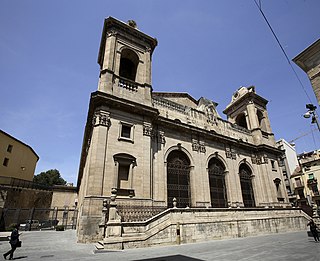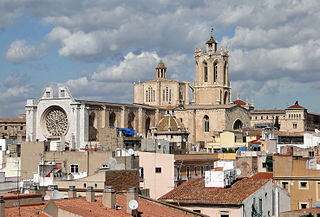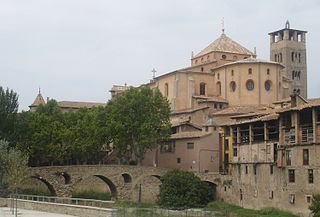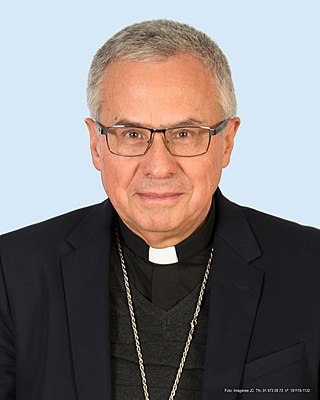
Vic is the capital of the comarca of Osona, in the province of Barcelona, Catalonia, Spain. Vic is located 69 km (43 mi) from Barcelona and 60 km (37 mi) from Girona.

The Diocese of Urgell is a Latin Church diocese of the Catholic Church in Catalonia (Spain) and Andorra in the historical County of Urgell, with origins in the fifth century AD or possibly earlier. It is based in the region of the historical Catalan County of Urgell, though it has different borders. The seat and Cathedral of the bishop are situated in la Seu d'Urgell town. The state of Andorra is a part of this diocese.

Pau Claris i Casademunt was a Catalan lawyer, clergyman and 94th President of the Deputation of the General of Catalonia at the beginning of the Catalan Revolt. On 16 January 1641 he proclaimed the Catalan Republic under the protection of France.
The bishop of Tortosa is the ordinary of the Roman Catholic Diocese of Tortosa in Catalonia, Spain. The bishop is a suffragan of the archbishop of Tarragona.

The Archdiocese of San Juan de Puerto Rico is a Latin Church ecclesiastical territory or diocese of the Catholic Church– comprising the northeast portion of the island of Puerto Rico. Its jurisdiction includes the municipalities of Dorado, Toa Baja, Cataño, Toa Alta, Bayamón, Guaynabo, San Juan, Trujillo Alto, and Carolina.

The County of Barcelona was a polity in northeastern Iberian Peninsula, originally located in the southern frontier region of the Carolingian Empire. In the 10th century, the Counts of Barcelona progressively achieved independence from Frankish rule, becoming hereditary rulers in constant warfare with the Islamic Caliphate of Córdoba and its successor states. The counts, through marriage, alliances and treaties, acquired or vassalized the other Catalan counties and extended their influence over Occitania. In 1164, the County of Barcelona entered a personal union with the Kingdom of Aragon. Thenceforward, the history of the county is subsumed within that of the Crown of Aragon, but the city of Barcelona remained preeminent within it.

The Diocese of Lleida, or Diocese of Lerida is a Latin Church diocese of the Catholic Church located in north-eastern Spain, in the province of Lleida, part of the autonomous community of Catalonia. The diocese forms part of the ecclesiastical province of Tarragona, and is thus suffragan to the Archdiocese of Tarragona.

The Archdiocese of Valencia is a Latin Church diocese of the Catholic Church located in north-eastern Spain, in the province of Valencia, part of the autonomous community of Valencia. The archdiocese heads the ecclesiastical province of Valencia, with authority over the suffragan dioceses of Ibiza, Majorca, Minorca, Orihuela-Alicante and Segorbe-Castellón. The archbishops are seated in Valencia Cathedral. On 28 August 2014, Pope Francis appointed Cardinal Antonio Cañizares Llovera as the next archbishop of Valencia.

The Archdiocese of Tarragona is a Latin Church ecclesiastical territory located in north-eastern Spain, in the province of Tarragona, part of the autonomous community of Catalonia. The archdiocese heads the ecclesiastical province of Tarragona, having Metropolitan authority over the suffragan dioceses of Girona, Lleida, Solsona, Tortosa, Urgell and Vic.

The Archdiocese of Barcelona is a Latin metropolitan archbishopric of the Catholic Church in northeastern Spain's Catalonia region.

The Diocese of Mallorca (Latin: Dioecesis Maioricensis is a Latin Church diocese of the Catholic Church located in the city of Palma, Majorca in the ecclesiastical province of Valencia in Spain.

The Diocese of Solsona is a Latin Church diocese of the Catholic Church located in the city of Solsona in the ecclesiastical province of Tarragona in Catalonia, Spain.

The Diocese of Vic is a Latin diocese of the Catholic Church with its seat in the city of Vic in the ecclesiastical province of Tarragona in Catalonia, Spain. Its cathedral is a basilica dedicated to Saint Peter.

The Diocese of Zamora is a Latin diocese of the Catholic Church in the city of Zamora in the ecclesiastical province of Valladolid in Spain.

Joan Terès i Borrull was presbyter of Vic, auxiliary bishop of Morocco (1575–1579), bishop of Elne (1579–1586) and of Tortosa (1586–1587), and archbishop of Tarragona (1587–1603). He was viceroy of Catalonia (1602–1603) and councillor of King Philip III of Spain.
Antoni Clarassó i Terès was a Spanish canon of the diocese of Urgell, treasurer-canon of the Cathedral of Barcelona, guest priest at the archdiocese of Tarragona (1588–1591), and vicar general of archbishop and viceroy of Catalonia Joan Terès i Borrull (1587–1599).
Antonio Pérez, O.S.B. was a Roman Catholic prelate who served as Archbishop of Tarragona (1633–1637), Bishop of Lérida (1633), and Bishop of Urgell (1627–1633).

Joan Planellas i Barnosell is a Spanish prelate of the Catholic Church. He has been serving as the archbishop of Tarragona since his installation on 4 May 2019. He previously served as a canon on the Girona Cathedral. He was also given the Missionary of Mercy title, that is a group of priests that were designated by the Pope to forgive serious sins normally only reserved to the Holy See. Barnosell became a priest in 28 March 1982.
















